Related Research Articles

Dartmoor is an upland area in southern Devon, England. The moorland and surrounding land has been protected by National Park status since 1951. Dartmoor National Park covers 954 km2 (368 sq mi).

Dartmoor Preservation Association (DPA) is one of the oldest environmental or amenity bodies in the UK. It was founded in 1883. It concerns itself with Dartmoor, a National Park in Devon, south-west England. It began with two main areas of concern. Firstly, commoners' rights were being eroded through army use, including the firing of live artillery shells, and piecemeal enclosure of land around the margins. Secondly, there was increasing public interest in Dartmoor's scenery, archaeology, history and wildlife
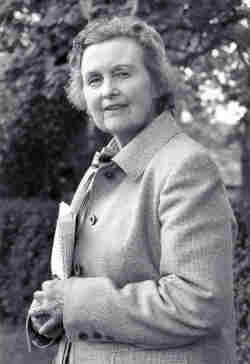
Sylvia Olive Pleadwell Sayer, Lady Sayer, was a passionate conservationist and environmental campaigner on behalf of Dartmoor, an area of mostly granite moorland in Devon in the south-west of England. She was chairman of the Dartmoor Preservation Association from 1951 to 1973, and remained deeply involved with the organisation until her death.

The Devonport Leat is a leat in Devon constructed in the 1790s to carry fresh drinking water from the high ground of Dartmoor to the expanding dockyards at Plymouth Dock.

Crazywell Pool or Crazy Well Pool is a large pond situated about 3 km (1.9 mi) south of Princetown just off the path between Burrator and Whiteworks on the western side of Dartmoor, Devon, England at grid reference SX582705. It is about 100 metres (110 yd) long and has a surface area of about 3,500 square metres.

Horrabridge is a village in West Devon, England with a population of 2,115 people in 2006, down from 2,204 in 1991. It is located approximately 12 miles (19 km) north of the city of Plymouth and 4 miles (6.4 km) south of Tavistock and is within the Dartmoor National Park. Horrabridge is a major part of Walkham electoral ward. The population at the 2011 census was 3,115.

Broadhempston is a village, parish and former manor in Devon, England, situated about 4 miles north of Totnes. It is now administered by Teignbridge District Council. According to the 2001 census the parish contained 257 houses with a population of 641.
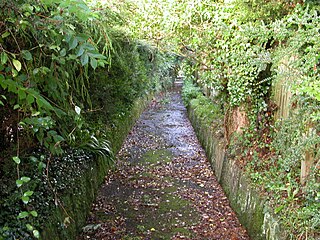
Drake's Leat, also known as Plymouth Leat, was a watercourse constructed in the late 16th century to tap the River Meavy on Dartmoor, England, from which it ran 17.5 miles (28.2 km) in order to supply Plymouth with water. It began at a point now under water at Burrator Reservoir, from which its path now emerges some 10m lower than the typical reservoir water level. It was one of the first municipal water supplies in the country.

Burrator Reservoir is a reservoir on the south side of Dartmoor in the English county of Devon. It is one of a number of reservoirs and dams that were built over the course of the 19th and 20th centuries in the area now covered by Dartmoor National Park to supply drinking water to the city of Plymouth and other rapidly growing towns in the surrounding lowlands.

The River Meavy is a river in the southwest part of Dartmoor in Devon in south-west England. It runs entirely in the national park and connects Burrator Reservoir to the River Plym.

Meavy is a small village, civil parish and former manor in the English county of Devon. Meavy forms part of the district of West Devon. It lies a mile or so east of Yelverton. The River Meavy runs near the village. For administrative purposes the parish is grouped with the parishes of Sheepstor and Walkhampton to form Burrator Parish Council, and for electoral purposes it is grouped with the same two parishes to form Burrator Ward.

Down Tor is a tor on Dartmoor, England, at GR 581694, height 366 metres (1,201 ft), overlooking Burrator Reservoir.

Sheepstor is a village, civil parish and former manor on the western side of Dartmoor in the county of Devon, England. In 2001, its population was 53, down from 95 in 1901. For administrative purposes the parish is grouped with the parishes of Meavy and Walkhampton to form Burrator Parish Council, and for electoral purposes it is grouped with the same two parishes to form Burrator Ward. Burrator Reservoir, constructed in 1898, is to the north of the village and forms part of the northern boundary of the parish.
Dartmoor Forest is a civil parish in Devon, England. It was formed in 1987 by the splitting of the former parish of Lydford. It covers about 56,000 acres (230 km2) entirely within Dartmoor National Park, and is the largest parish in Devon. Despite its size its population in 2001 was only 1,619. Due to its large size it is surrounded by many other parishes: these are, clockwise from the north, Belstone, South Tawton, Throwleigh, Gidleigh, Chagford, North Bovey, Manaton, Widecombe in the Moor, Holne, West Buckfastleigh, Dean Prior, South Brent, Ugborough, Harford, Cornwood, Shaugh Prior, Sheepstor, Walkhampton, Whitchurch, Peter Tavy, Lydford, land common to the parishes of Bridestowe and Sourton, and Okehampton Hamlets.

Walkhampton is a village and civil parish on the western side of Dartmoor in the county of Devon, England. The village lies on the Black Brook, a tributary of the River Walkham, about 7 kilometres (4.3 mi) south-east of Tavistock, near the villages of Horrabridge, Yelverton and Dousland. Burrator Reservoir, constructed in 1898, is to the south-east.

The Princetown Railway was a 10¼ mile single track branch railway line in Devon, England, that ran from Yelverton on the Plymouth to Tavistock line, to Princetown via four intermediate stations, Dousland, Burrator and Sheepstor Halt, Ingra Tor Halt and King Tor Halt. The line closed in 1956 and today forms part of a popular cycling and walking route.
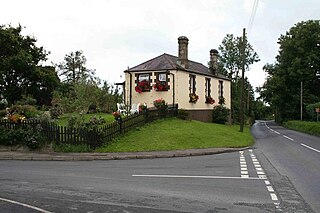
Dousland railway station, originally opened at Dousland Barn in 1883 was located on the 10.5 mile long single track branch railway line in Devon, England, running from Yelverton to Princetown with eventually four intermediate stops, three being halts and one at Dousland as a fully fledged station.
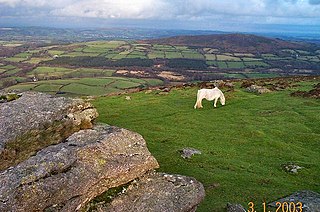
King Tor Halt railway station was located on the 10.5 mile long single track branch railway line in Devon, England, running from Yelverton to Princetown with four intermediate stations. It was opened with only a basic wood platform and shelter in connection with the adjacent granite quarry and the associated worker's houses. Its later traffic was entirely walkers and like Ingra Tor Halt it was retained in an attempt to counter competition from local bus services and encourage tourist traffic.
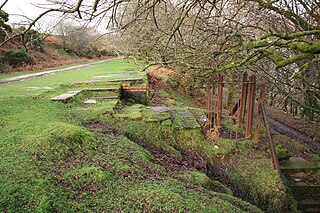
Burrator and Sheepstor Halt railway station was located on the 10.5 mile long single track branch railway line in Devon, England, running from Yelverton to Princetown with eventually four intermediate stations. The station was opened as Burrator Platform and became Burrator Halt when it was opened to the public, the name being changed again in 1929 to Burrator and Sheepstor Halt.
References
- ↑ "Ward population 2011". Archived from the original on 5 March 2016. Retrieved 16 February 2015.
- ↑ "Burrator Perambulation". Dartmoor Search and Rescue Team Plymouth. Archived from the original on 28 July 2015.
- ↑ Barley, p. 228.